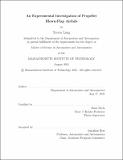An Experimental Investigation of Blown-Flap Airfoils
Author(s)
Long, Trevor
DownloadThesis PDF (18.31Mb)
Advisor
Drela, Mark
Terms of use
Metadata
Show full item recordAbstract
At present, there is significant interest in electrically-powered Urban Air Mobility (UAM) aircraft that can operate in constrained take-off and landing areas (TOLAs) for a variety of missions. While many present designs use vertical take-off and landing (VTOL) capabilities to fulfill this requirement, fixed-wing aircraft utilizing distributed electric propulsion (DEP) to enable blowing across their wings may be able to provide competitive performance while decreasing energy requirements for take-off and landing. In this thesis, the performance of blown-flap wings is investigated to provide both performance estimates and validation data for future work on blowing enabled aircraft.
A quasi 2-dimensional wind tunnel model is used to conduct surveys on both the performance and flow characteristics of propeller blown-flap airfoils. These surveys produced accurate estimates for the cₗ,cₓ,cₘ performance of these wings as a function of the test parameters of angle of attack, 𝛼, flap deflection, 𝛿 subscript f, and blowing power, Δcj. In proper operating regimes, maximum cₗs of over 9.5 were observed, and cₗs over 5 were shown to be easily achievable given proper design. From the surveys of the wake and boundary layer development, the individual propeller slipstreams were found to spread very evenly across the span of the wing, suggesting that 2-dimensional estimates of blown wings may be used for design and analysis of blown wing sections. Stall on the flap upper surface was found to be the primary cause of decreases observed in attainable cₗ as 𝛿 subscript f was increased, and that this stall region was stable and unchanged by increased blowing. Changing the flap geometry was found to delay the onset of this stall and increase performance. Areas of interest moving forward are also identified.
Date issued
2021-09Department
Massachusetts Institute of Technology. Department of Aeronautics and AstronauticsPublisher
Massachusetts Institute of Technology